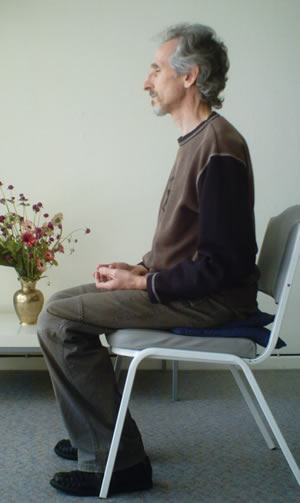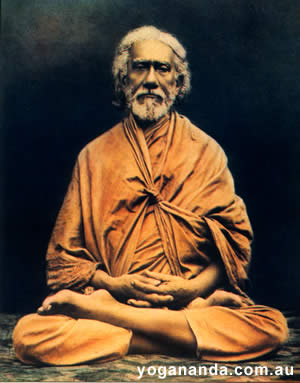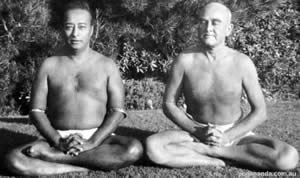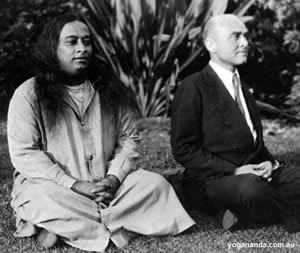MEDITATION (2)
Meditation Posture
Firmly holding the spine, neck, and head erect and motionless, let the yogi focus his eyes at the starting place of the nose (the spot between the two eyebrows); let him not gaze around in various directions.
—The Bhagavad Gita VI:13
A majority of Gita translators and commentators have misinterpreted the word nasikagram to mean "tip of the nose." The word literally means "origin of the nose." The origin or starting place of the nose is the spot between the two eyebrows, the seat of spiritual vision.
Meditation involves the withdrawal, through the spine, of life current from the sensory nerve branches, and the concentration of that accumulation of life force within the spherical spiritual eye. A straight spine and erectness of the neck and head are important in effective meditation. If one adopts an improper posture—his body bent, or his chin tilted up or down—his crooked vertebrae pinch the spinal nerves. This pressure obstructs the reversed flow of mind and life force from the sensory channels to the brain; there is then no reinforcement of the power of the inner telescopic eye to perceive Omnipresence.
 One should sit in a comfortable posture with the spine erect. The lumbar region of the spine (opposite the navel) should be gently crooked forward, the chest up and shoulders back (which places the inner edges of the shoulder blades closer together). Each hand, palm upturned, should be put on the corresponding thigh at the juncture of the thigh and abdomen to prevent the body from bending forward. The chin should be parallel to the floor. While maintaining this correct position, undue tension in the muscles should be relaxed. When the yogi holds the spine in the form of a bow by the above-mentioned posture, he is ready successfully to engage his reversed mind and life force in a battle with the outwardly pulling senses. Without any strictures or pinching of the spinal nerves, the mind and life force are easily directed upward by the yogi.
One should sit in a comfortable posture with the spine erect. The lumbar region of the spine (opposite the navel) should be gently crooked forward, the chest up and shoulders back (which places the inner edges of the shoulder blades closer together). Each hand, palm upturned, should be put on the corresponding thigh at the juncture of the thigh and abdomen to prevent the body from bending forward. The chin should be parallel to the floor. While maintaining this correct position, undue tension in the muscles should be relaxed. When the yogi holds the spine in the form of a bow by the above-mentioned posture, he is ready successfully to engage his reversed mind and life force in a battle with the outwardly pulling senses. Without any strictures or pinching of the spinal nerves, the mind and life force are easily directed upward by the yogi.
Meditation involves the withdrawal, through the spine, of life current from the sensory nerve branches, and the concentration of that accumulation of life force within the spherical spiritual eye. A straight spine and erectness of the neck and head are important in effective meditation. If one adopts an improper posture—his body bent, or his chin tilted up or down—his crooked vertebrae pinch the spinal nerves. This pressure obstructs the reversed flow of mind and life force from the sensory channels to the brain; there is then no reinforcement of the power of the inner telescopic eye to perceive Omnipresence. (p.608)
Lotus Posture

Those Western yogis, especially youths, who can squat on the floor like Orientals, will find their knees pliable, owing to their ability to fold their legs in an acute angle. Such yogis may meditate in the lotus posture, or in the more simple cross-legged position.
No one should try to meditate in the lotus posture unless he is at ease in that position. To meditate in a strained posture keeps the mind on the discomfort of the body. Meditation should ordinarily be practiced in a sitting position. Obviously, in a standing posture (unless one is advanced) he may fall down when the mind becomes interiorized. Neither should the yogi meditate lying down, for he might resort to the "practiced" state of slumber.
Meditation Time
There is a proper time and proper place for performing one's different duties. Just as sleep takes place at night in a quiet bedroom, as business is carried on during working hours in an atmosphere of business, and as intellectual studies are carried on in scheduled times in the halls of learning or in a quiet library, so, there should be a proper time and place for meditation, or God-communion. Whatever be one's sanctuary of solitude, he will find it especially beneficial to pray and meditate any time during the following periods: from the earliest hour of dawn, from 5 to 8 a.m.; noontime from 10 a.m. to 1 p.m.; evening from 5 to 8 p.m.; and night time from 10 p.m. to 1 a.m. The masters of India have taught that the hours surrounding the transitional times of dawn, noon, sunset, and midnight of each solar day are conducive to the cultivation of spiritual development.
The magnetic cosmic laws of attraction and repulsion that affect the body are more harmoniously equilibrated during the above four periods. This helps a meditating individual to interiorize himself in divine communion. To meditate in the quietness of the early mornings and at night is to meditate in a solitary place. During those times, most people are asleep, and the city, or one's surroundings, are quiet. The results of peace realized from meditation are easily obtained due to less noise and wrong vibrations of restless people. (Discourse 25)
Meditation Length
 If anyone, even twice daily, during the hours of dawn and in the depth of night, worships God in the temple of meditation for fifteen minutes to one hour, he will find the spiritual habit of peace diminishing his worry-producing material habits.
If anyone, even twice daily, during the hours of dawn and in the depth of night, worships God in the temple of meditation for fifteen minutes to one hour, he will find the spiritual habit of peace diminishing his worry-producing material habits.
But there will be those who cannot bring themselves to set aside even a half hour out of twenty-four to meditate: the so-called too-busy person—busy until death with a myopic foolish pursuit of perishable treasure to satisfy unsatisfying desires. Stocks and bonds and vain accumulations cannot pass through the pearly gates of the afterlife, leaving the astral being to rue its paucity of spiritual wealth. Such persons ought at least to make their best effort weekly to commune with God at church or temple or other place of worship—not merely bringing the body to services while the heart and mind are rehashing the worries of the business week, but giving one's devotion to God with attentive sincerity, a calm body, and a quiet mind. (Discourse 39)
Meditate with the Guru
 Deeply meditating disciples should concentrate on their guru, or meditate with him if possible. Those who are spiritually advanced do in fact meditate with the guru by visualizing him in the spiritual eye and tuning in with him, whether or not they are in his physical presence. During meditation the spiritual vibration of a great master silently works on lesser yogis who may be meditating with him or who are in tune with him, regardless of distance. It is sufficient for a disciple to think strongly of his guru before meditation. He will then find his meditation on God to be reinforced by the Lord's power flowing through the direct tangible channel of the guru. (Chapter VI, God Talks With Arjuna: The Bhagavad Gita by Paramahansa Yogananda)
Deeply meditating disciples should concentrate on their guru, or meditate with him if possible. Those who are spiritually advanced do in fact meditate with the guru by visualizing him in the spiritual eye and tuning in with him, whether or not they are in his physical presence. During meditation the spiritual vibration of a great master silently works on lesser yogis who may be meditating with him or who are in tune with him, regardless of distance. It is sufficient for a disciple to think strongly of his guru before meditation. He will then find his meditation on God to be reinforced by the Lord's power flowing through the direct tangible channel of the guru. (Chapter VI, God Talks With Arjuna: The Bhagavad Gita by Paramahansa Yogananda)
Every day's meditation
must be deeper
than yesterday's.
The Five Parts of Meditation
By Brother Bhaktananda
(1) First is to begin with a prayer, invoking the presence of God and the Gurus in our meditation, asking Their guidance and praying that They give us what we need for our spiritual growth at this time. Pray from the heart, not from the mind. Words offered superficially from the mind do not touch God. The Lord does not have to respond to that kind of prayer, Master used to say, but He has to respond to love. That is His law.
(2) Next comes chanting. Singing a devotional chant helps us to concentrate our thoughts and awakens our love for God. It helps us to get in the mood for meditation.
(3) Third comes practice of the yoga meditation techniques. These are taught in the Self-Realization Fellowship Lessons. When you practice them with concentration and devotion, they produce a state of deep peace and calmness.
(4) Then, Master said,
"Sit a long time in the stillness."
That is the fourth part of meditation.
"Stillness" means no restless thoughts, not even praying. Just be aware of the spiritual eye—keep the mind riveted at the Christ Center. As the Bible says,
"Be still,
and know that I am God."
(Psalm 46:10)
To have any spiritual experience, the body must be still, the mind must be still, and the feelings must be still.
(5) Finally, when the body and mind begin to get restless after sitting in the stillness as long as you can, that is the time to practice devotion. Talk to God from the heart. Tell Him: "I love You. I am seeking You. You are the most important thing in my life." And it is at this time too, that you can talk with God about any problems you may have. Then close with a prayer. Each of these five parts—prayer, chanting, techniques, sitting in stillness, and devotion—-is very important and should be practiced in our daily meditations.
![]()